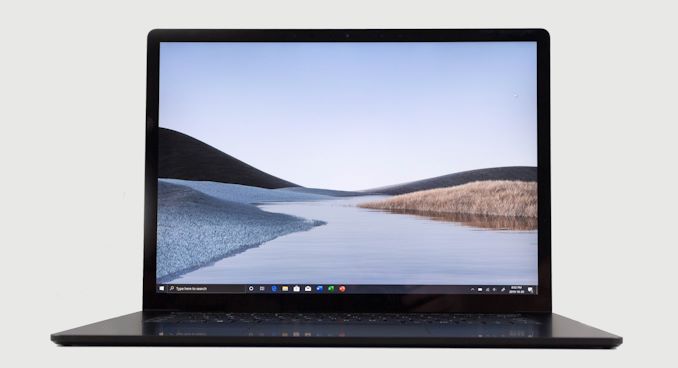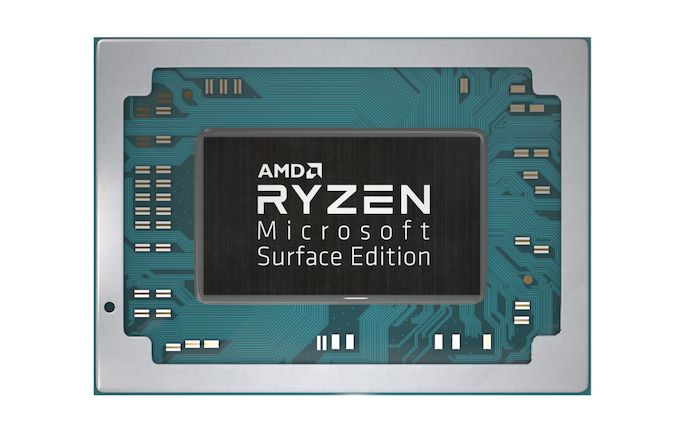The Microsoft Surface Laptop 3 Showdown: AMD's Ryzen Picasso vs. Intel's Ice Lake
by Brett Howse & Andrei Frumusanu on December 13, 2019 8:30 AM ESTFinal Words
Two laptops. Two platforms. It is rare to have a chance to see a manufacturer offer such equal footing to both AMD and Intel by outfitting a premium laptop with processors from both. It represents a rare opportunity to get to test the latest processors from AMD and Intel in a laptop in such an apples-to-apples fashion.
In the laptop space, design, cooling, and a manufacturers requirements can play a big part in how a particular chip performs, thanks to adjustable power level settings, surface temperature adjustments, and more. We have seen the lowest tier CPU outperform the highest tier CPU just by the virtue of a better cooling system, so to have processors from AMD and Intel, both of which launched in 2019, in the same chassis is a wonderful opportunity.
There aren’t too many ways to sugar coat the results of this showdown though. AMD’s Picasso platform, featuring its Zen+ cores and coupled with a Vega iGPU, has been a tremendous improvement for AMD. But Intel’s Ice Lake platform runs circles around it. Sunny Cove cores coupled with the larger Gen 11 graphics have proven to be too much to handle.
On the CPU side, no one should be too surprised by the results. We've already seen on the desktop that AMD’s Zen+ cores were competitive, but slightly slower than the previous Skylake platform; and the new Sunny Cove microarchitecture from Intel is a big step forward in terms of IPC for Intel. On purely CPU based tasks, Ice Lake really stretched its legs, and despite this being a 3.9 GHz chip, in single-threaded SPEC 2017, it managed to come very close to a 5.0 GHz Core i9-9900K with a massively higher TDP. Zen+ is outclassed here, and that showed in the benchmark results, and especially in the benchmark time. On our 8-thread SPEC 2017 run, the Ice Lake platform finished just a hair over two hours ahead of Picasso.
But things fare better for AMD on the GPU side of matters. Even though Intel has certainly closed the gap with Ice Lake's iGPU, AMD seems to continue to hold an advantage, especially on the 11 Compute Unit Ryzen Surface Edition processor found in the Surface Laptop 3. Intel has dedicated a lot more die area to the GPU and the results put them almost on equal footing with the Vega based GPU on Picasso. On the more complex GPU tasks, AMD tends to have a slight lead, and AMD’s low-level driver support also seems to benefit them on DirectX 12 based tasks. But, Ice Lake’s GPU is helped by the much quicker CPU it is coupled to, so depending on the specific test it can be even quicker.
Ice Lake does all of this with much better power efficiency as well. Overall battery life is quite a bit longer, and idle power draw is notably lower as well. Case in point: at minimum screen brightness, the Ice Lake system was pretty much only sipping power, drawing around 1.7 Watts, versus the 3.0 Watts for the AMD system.
It was fantastic to see AMD get a design win in a premium laptop this year, and the Surface Laptop 3 is going to turn a lot of heads over the next year. AMD has long needed a top-tier partner to really help its mobile efforts shine, and they now have that strong partner in Microsoft, with the two of them in a great place to make things even better for future designs. Overall AMD has made tremendous gains in their laptop chips with the Ryzen launch, but the company has been focusing more on the desktop and server space, especially with the Zen 2 launch earlier this year. For AMD, the move to Zen 2 in the laptop space can’t come soon enough, and will hopefully bring much closer power parity to Intel’s offerings as well.
Meanwhile for Intel, Ice Lake has been years in the making, and, after a long delay, it is finally here. After digging into the platform in-depth, it’s clear that Ice Lake is an incredibly strong offering from Intel. The CPU performance gains are significant, particularly because they were made in the face of a CPU frequency deficit. But the biggest gains were on the GPU side, where Intel’s Gen 11 GT2 in its full 64 Execution Unit configuration is likely the biggest single increase in GPU performance since they started integrating GPUs. It pulls very close to AMD’s Vega, closing the gap in performance to almost zero.
2019 has been a big year in the laptop space, with both Intel and AMD bringing new tools to the game. 2020 should be just as exciting, and if we’re lucky, we’ll get another chance to do this all over again.













174 Comments
View All Comments
Zoolook - Saturday, December 21, 2019 - link
@RSAUser I think you nailed it, it's better for their bottom line to dedicate 7nm chips to products with higher margins.shabby - Friday, December 13, 2019 - link
What is amd waiting for with zen 2 for mobile? Are they prioritizing desktop and server chips first or is there a lack of capacity at tsmc with everyone hogging the 7nm process?RBD117 - Friday, December 13, 2019 - link
I think it's a mix of everything. Renoir is being worked on actively but AMD doesnt have enough resources to do all of Ryzen AM4, EPYC, and Ryzen Mobile at the same time. The desktop and server chips were prioritized first as those have clear wins over Intel solutions. Mobile however requires a lot more work with battery life and performance optimization. And yeah, we already see chip production issues with Ryzen 16 and 12-core as it is with most of the chips going to EPYC so Zen2 mobile would just add more capacity issues.Targon - Friday, December 13, 2019 - link
AMD should be releasing the Zen2 laptop chips at or around CES 2020(in another three weeks). Microsoft was probably preparing the Surface Laptop a good five months ago so AMD just didn't have samples ready for Microsoft at that time.sing_electric - Friday, December 13, 2019 - link
Realistically, TSMC's 7nm process (used in Zen 2's compute chiplets) is expensive and capacity-constrained. AMD gets around this on desktop by creating a separate IO die on an older, cheaper process, but that doesn't scale well to mobile.To get Zen 2 on mobile, they'd likely need everything - compute, IO and GPU - to be on 7nm, and the chip would be considerably larger than (desktop) Zen 2's compute chiplet.
AMD basically had a choice - for a given number of 7nm wafers, they could get a few mobile APUs or a lot more desktop CPUs (and GPUs for their 7nm options). The margins are much better doing the latter, so that's what they did.
There's also the fact that we don't know what their agreement is with Global Foundries on 14/12nm wafers - we do know that AMD's agreement with them didn't require GloFo to finish its 7nm process. AMD has a commitment to buy some number of wafers from GloFo per year for a certain length of time, and it's likely that is a factor as well.
lmcd - Friday, December 13, 2019 - link
Disagreed -- cheaper IO dies have worked on mobile for years. The "cheaper" process is literally the process Zen+ shipped with.Problem is entirely integration -- now that Navi (a major release) has shipped, AMD can integrate the current version into chiplet form, then port those integrations to the incremented version of Navi ready to ship next year. Since the chiplets provide a substantial level of decoupling, incremental upgrades should be reasonably easy to integrate.
RSAUser - Friday, December 13, 2019 - link
Doubt the I/O die size matters in this case, doesn't scale down well so not an issue.Most likely a supply issue and getting Navi to integrate.
scineram - Monday, December 16, 2019 - link
What Navi?AnGe85 - Friday, December 13, 2019 - link
AMD is a smaller company with fewer resources, as you can see with various things. The step by step Navi Launch (currently only Navi 14 is additionally available), delayed 3950X launch, the fragmented Threadripper launch, not until early 2020 Renoir with Zen2, but only combined with Vega (not Navi) and there's still the question when desktop APUs will hit the market.The new suface models presumably have been in development for about a year or even longer. There was no mobile Zen2 in sight ... and this also applies to Apple's Mac Pro and stupid demands like "it should have been Threadripper, not Xeon W". There was no appealing Threadripper available (the old 2000 series still has various flaws and limits and the Mac Pro is an even more complex platform).
Additionally at this point, I would assume, that Microsofts strategy (with the two AMD and ARM models) is more about keeping Intel in check according to pricing and cooperation.
The ARM Pro X has obvious limits and Microsoft also knew about AMDs comparability in advance. Additionally you can assume, that there is a good reason for Microsoft to offer channel consumers to the AMD 15" model (and to limit the Ice Lake model to business users), most likely, because they have to sell x K SKUs to make this experiment (or this Intel pressurizing model?) worthwhile. Maybe with next surface updates in 2021 AMD will be more competitive.
5080 - Friday, December 13, 2019 - link
Margins. EPYC, Threadripper have a much higher margin than mobile APU's.